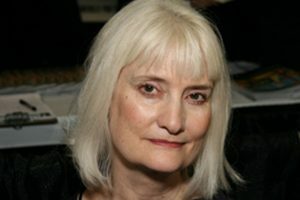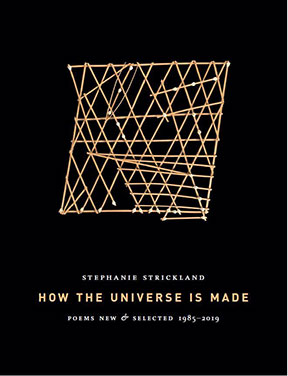The Universe Is Made: Poems New and Selected 1985 – 2019
Stephanie Strickland
Ahsahta Press, 2019.
Paperback, 302 pages
Review by Terese Svoboda
How the Universe is Made is a paradoxical title for a Selected, with its present tense wagging a godlike continual making. It also captures Strickland’s tendency to explain – albeit never as a didact – parts of the universe that are hard to grasp, be it the quarkiness of physics or the newly-invented telepresence. The book’s contents were chosen from eight prize-winning books of text and outlines of eleven hypertext/computer-based projects – the media being the most obviously inexhaustible. On the book’s cover is a Micronesian navigation map, the title’s visual analogy, as it describes the entire known world with its arrangement of twigs and shells. The ones and zeroes of her computer-generated projects?
“Lineage – Linkage – Homage,” an original rethinking of a dedication, announces the breadth of this universe. Scattered over two pages is everything from Detroit’s Lake St. Clair to Hardy’s The Mellstock Quire,(alternative title to Under The Greenwood Tree) to the Canadian poet Tim Lilburn to Mother Goose. Though Susan Howe and her eclectic rendering of texts, and Lorine Niedecker with her spare line and attention to the invisibility of women’s work are obvious influences, Simone Weil appears throughout the Selected and is the subject of her third book, Red Virgin. A French philosopher, political activist and mystic who starved herself to death in protest of the Nazi occupation of France, Weil believed (among other things) that the world points to something beyond itself. Mathematics and science, especially computer science, communicate complicated abstraction through language beyond themselves – and they are Strickland’s main concerns. In “0 Shortcut to What?,” (True North) she quotes mathematician Willard Gibbs’ only comment at a faculty meeting, after decades of attendance: “Mathematics is a language.” Gibbs was the subject of a biography by Muriel Rukeyser and, according to Einstein, “the greatest mind in American history.” (Does this also say something about faculty meetings?) Around the same time – the turn of the century – the crazed Russian Futurist, Velimir Khlebnikov actually tried the reverse, to reduce poetry to mathematics. Although readers will see few equations in this book, they will read many a “statement[s] that is efficient in every respect,” another line from “0 Shortcut to What?” describing Gibbs’ single sentence, and an excellent definition of poetry.
Strickland skips her first book entirely and begins with Give the Body Back and its poem,“Seeing A Medusa,” in which a jellyfish is caught from the side of a boat and flung back into the ocean, a gesture rich in the feminine.
Only that tinge of crimson-pink
like cyclamen flashing
drew me down, made me see youin the heave of the wake
Echoing this poem is “MEASUREABLE pleasures” from Dragon Logic, a much later book. It cites the octofungi, an inorganic anemone that appears to be alive when it responds to light. Both creatures are anthropomorphized with their need to “get clear” – escape. The medusa “was you – alive!” flung back into the sea, and the other, the octofungi, is urged to “Jump the bitomic/atomic barrier” and become alive.
For a book that begins with Give the Body Back and ends with The Body Obsolete, little is overtly personal, aside from “Mother, Dressed Up,” its second poem. With this, she introduces the maternal that hovers over so many of the poems, but whose body withdraws.
I am stunned
by your body, trying
to hideits eagerness
to pull away
from mine.
A book later, the poem “The Soul Learns Everything From The Body” describes the aftermath of such a withdrawal: “The body,/unastonished by reduction; it feels/what can be shown.” Strickland keeps to the shown. Only two other poems in the entire Selected touch on the lived life, one mentioning a dying mother ( “Your Death: What is Said”), perhaps a conflation with Weil’s death, and the other a chemically sensitive daughter ( “Introductions”). Instead Strickland celebrates the complexity of the cerebral: wordplay comes to the fore in her middle books, a test of the reader’s tolerance for obscurity (at least of the average poet’s knowledge of math and science) amid little miracles of imagery, served up with punctuational rigor, and often an extreme sensitivity to the positioning of text.
Iota
and her anti-self
cancel: Iota,
dividing herself, is still
hidden: none,
but one; but Iota+
returned to herself, overlaying
herself, an enfolding
Revelation
of One who-is-and-is-not-one, who is Not-one, who
returned
to herself is real, and Minus: rotational
Spine
– Girder and
Axis
of description in the
(actual) quantum
mechanical
world, in the
Body
Electric.
+(-1)1/2
Zone: Zero contains my favorite poem, electronic or paper, “Ballad of Sand and Harry Soot,” the silicon chip vs. the cabon-based. Aurally very beautiful, with sound leading association, each spare line scours the mind for what silica and its revolution hath wrought. It is equally an achievement electronically. Also included in Zone: Zero are very complex poems encased in charts: “War Day” and “Slippingglimpse,” the second also an electronic piece.
The entire first word or first several words of each poem in Dragon Logic are capitalized as sort-of-title, the first signal in this book that Strickland, like Susan Howe, will take no part of poetry—typographical, sonic, spatial, or connotative—for granted. She uses nearly every symbol on the keyboard to force the reader to reconsider signs on the page. Her strict but uncommon syntax can usher the reader into new meaning midline, her tendency toward modernist enjambment, piling nouns on nouns, often suggest the progression or the expansion of a concept, rather than a simple causal linking, as in “idolizing idle incubus’s/incubation idyll isolated Individual/infatuates itself” (“GREAT Pan is dead.”) Her lines can become so densely sonic that the ear delights before the mind can gather: “Octavia swallowing mandorla martini/glasses of unclouded/gin in the permadim grotto/of echoing surfaces a faint jade in the beveled edge hint of mint” (”KEEP it | kill it call it! Up”) Recalling the cover illustration, in “LINES spears nets knots have-nots” she unites the genius of the Micronesian navigation maps with the tatting of an aunt who “bore [it] to her grave for want/of a human relay.”
Strickland’s new poems are gathered under the title “The Body Obsolete.” Pacing and positioning have completely replaced punctuation, subjects do not unfolds sequentially but rather contiguously, allowing much mystery to infiltrate the jumps, and the footnotes become essential. She’s not one to let the possibility of inflection pass her by, and her italics indicate almost another lexicon at work, certainly tonal:
While-and-for the huge plus of Evolution – patchy, crazy-quilt
lack of optimal adaptation
“Four Fates – Spin-Stir” is a challenging first read. So is Stevens, on occasion. His playfulness is echoed in many of these poems, but a Stevens crossed with Mary Kenneth Keller, the nun who earned the first PhD in computer science:
So/Lo having no need of name/s pre-Adamic Alone Prior
all raging crooning urge orchestrated if at all
by blind chaosmosis in some bricologic orderall vacuum mass/equivalent roiling to emerge all
hardrock pulse haltered liable to erupt but no pool
no faultless glance no direct inspection or candid reflection
Several pictures support the text in the new poems, essential for understanding complex mathematical figures. (“Collins Says How” and “Gormley vs. Stelarc”). Always, a darting sharp intelligence dares the reader to follow, impatient with empathy, refusing prompting, overlaid with a grave concern for women in a catastrophic world. The ur moment of understanding the abstract mathematical/poetical world that has intrigued the poet for so many decades appears in the little five-year old girl put forward at the very end of the text portion, in an orchestral drawing-together of all the power in the (uni)verse:
The child’s distress, a cloud fast pass across her face
furrowed brow clash – she is trying to takeit in, has long past taken it in, she tries to ‘get it’
to proffer a solution, then another, she is five
Positioning her electronic achievements after the poetic makes sense only because How The Universe Is Made is print. Strickland is more than a mother of electronic poetry, she is among its deities. Many were called when hypertext appeared in the 1990s, but very few poets took up its rigors. Yes, poets could imagine the potentiality of the “hot link” of a single word the way Emily Dickinson left variants for a handful of her poems, but tracking branching lines and even stanzas through the 3-D of “choose-your-own-adventure” in order to make meaning and resonance? True North structures a poem in 3-D in which poems spin on an axis. In Slppinglimpse water reads text, text reads tech, and tech reads water to be read at any speed, resolution or direction. Strickland, along with collaborators, also built poem “generators” that automatically produce strings of words algorithmically related to themes and visual presentations. In Sea and Spar Between, waves (not to be confused with (or perhaps to be confused with) generators that produce different types of electrical waveforms over a wide range of frequencies known as wave generators) use Dickinson and Melville’s lexicons and no horizon, sweeping the reader under literal waves of language. Honoring Aaron Swartz’s suicide over his prosecution for freeing data, Strickland and programmer Ian Hatcher produced House of Trust. Ringing The Changes, her most recent electronic poem generator, makes phrases based on patterns made by bell-ringers with their seven bells, exhausting the sequences in “as many fish in the sea” – only 27 trillion tries. A lot of the results spew a kind of language poetry, the weight of the words woven through a text creating and un-creating or torquing meaning, a “liveliness” perhaps hearkening back to the many-appendaged octofungi and medusa in her text-based work.
No other poet has plumbed or plummed with her thumb so deeply into the pies (πs) of physics, math, myth and computers and made them interlock on the atomic level. Yes, the poems sometimes become maddeningly esoteric. Turn to the footnotes, use google. Learning is not antithetical to poetry. Emotion is not the only point of poetry, and certainly not confession. More than just the material world holds beauty.
 Terese Svoboda is the author of eight books of poetry, including a new one, Theatrix, forthcoming from Anhinga in 2021. She has also published seven books of fiction, a memoir, a biography and a book of translation from the Nuer. Great American Desert, a book of stories, was published this year.
Terese Svoboda is the author of eight books of poetry, including a new one, Theatrix, forthcoming from Anhinga in 2021. She has also published seven books of fiction, a memoir, a biography and a book of translation from the Nuer. Great American Desert, a book of stories, was published this year.
